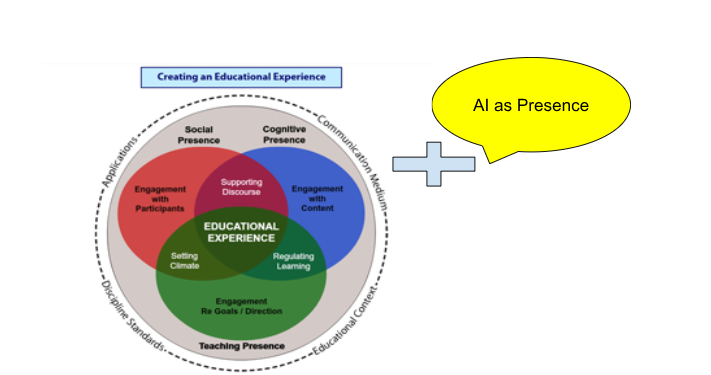By Jenny (Jing) Mao, learning transformation specialist, Coast Mountain College
Recently, I had the opportunity to visit a first-year chemistry classroom and collaborate with a learning specialist, the subject instructor, and students in the lab to discuss the ethical use of AI for their coursework. The process was interactive, interesting, and engaging. As an educational developer mainly focused on faculty support at Coast Mountain College (CMTN), I realized the importance of interacting with different perspectives and supporting students’ learning using collaborative practices. In a supportive environment, students can openly explore AI tools while understanding the importance of ethical and responsive use of technical tools to assist their learning.
In this blog post, I’ll share insights from the classroom collaboration within CMTN’s teaching and learning context, as guided by the community of inquiry (CoI) framework, to consider the impact of AI uses. I hope this practice inspires others to explore similar approaches in their own institutional contexts.
Teaching and Learning Context at Coast Mountain College
CMTN provides students with diverse learning environments at campuses in several northern communities. With a prioritization of experiential place-based learning (EPBL) and providing a strong link to local communities, the college is committed to inclusive, small-group, and community-based learning across its programs. This distinctive context provides a solid foundation for collaborative efforts among faculty, staff, and students, enabling them to bring diverse perspectives and experiences to their interactions with AI tools.
Framework: Community of Inquiry
The CoI framework was informative as I prepared for and participated in this collaborative classroom visit, particularly in light of AI’s growing impact on education. As the graphic below illustrates, CoI in education refers to a group of individuals collaboratively engaging in the process of creating deep and meaningful learning experiences. This is achieved through the interplay of three core elements: social presence, cognitive presence, and teaching presence.
During the classroom visit, we worked together to create an engaging learning environment by openly exploring how students can use AI tools ethically and responsibly by emphasizing learner agency, building critical AI literacy, and following ethical guidance.

Figure: Creating an educational experience, Community of Inquiry, n.d.
Collaborative Case Overview
In the classroom collaboration, we began by conducting a brief survey to assess students’ familiarity with AI tools, followed by a 30-minute interactive demonstration showcasing NotebookLM as a study aid. Within the classroom setting, the instructor encouraged students to experiment with AI tools to assist in writing lab reports, emphasizing the importance of reflection and critical thinking. During the demonstration, the learning specialist uploaded a digital copy of the course content to NotebookLM to illustrate how the tool can summarize chapter content and even generate a podcast based on the material. Both students and the instructor found these features valuable, noting how they could support course content previews and foster deeper engagement with subject knowledge.
As a co-facilitator, I provided some guidance on cultural differences in academic writing and introduced students to the college resources available to support their learning. From my observations, students exhibited varying levels of familiarity with AI ranging from confident early adopters to those with little or no prior experience. The latter group showed a lack of awareness or concern about academic misconduct as a barrier to using AI tools. Overall, this hands-on session not only showcased AI’s potential as a learning aid, but also initiated meaningful discussions about its ethical and practical role in academic settings.
Reflections: Collaboration as Pedagogy
Reflecting on this collaborative practice, I’ve noted a few key insights that emerged from the experience.
- Creating a community of ethical AI use: Modelling responsible AI use, in partnership with the instructor, helped establish a classroom-wide ethic of integrity. The collaborative experience allowed students to see that ethical AI use is a shared value, not just a rule.
- Encouraging critical engagement: By treating AI as a tool rather than a shortcut, we encouraged students to stay actively engaged in their learning process. This approach not only deters dependency on AI, but also helps students develop critical thinking skills.
- Offering clear ethical guidelines: Providing straightforward, practical guidelines for when and how to use AI can demystify responsible use. Educators can use and tailor peer-reviewed resources or frameworks such as the B.C. Digital Literacy Hub or A Framework for AI Literacy. By establishing clear expectations, we can prevent common misunderstandings and create a safer learning environment.
Moving forward, it is essential to continue fostering critical AI literacy by embedding these conversations into course design and faculty training. As outlined in UNESCO’s Guidance for generative AI in education and research (2023), the safe and effective use of AI should be co-designed by learners, instructors, and researchers. Collaborative classroom visits like this one serve as powerful opportunities to build awareness, understanding, and confidence around AI’s integration into college classrooms. As AI continues to shape the learning landscape, we should put continuous efforts into empowering students and instructors to use these tools, thoughtfully, ethically, and effectively, in ways that enrich the educational experience.
Learn More
- Digital Pedagogy Toolbox: Resilient Teaching in the Age of AI with Dr. Bonnie Henry’s Principles – Be kind, be calm, be safe
- Digital Pedagogy Toolbox: Cultivating (Gen)AI Literacy – Moving Past AI Pedagogy’s Hype
- The GenAI in Teaching and Learning Toolkit
About the Author
Jenny (Jing) Mao is an Educational Transformation Specialist at Coast Mountain College. She holds a Ph.D. in Education from the University of Victoria, with expertise in English as an Additional Language (EAL) and English for Academic Purposes (EAP). She advocates for an educative approach to academic integrity and the ethical use of GenAI. Jenny is committed to faculty development and fostering an equitable and inclusive learning environment for all learners.
References
Community of Inquiry. (n.d.). The Community of Inquiry. Athabasca University. https://coi.athabascau.ca/
UNESCO. (2023). Guidance for generative AI in education and research. https://www.unesco.org/en/articles/guidance-generative-ai-education-and-research
